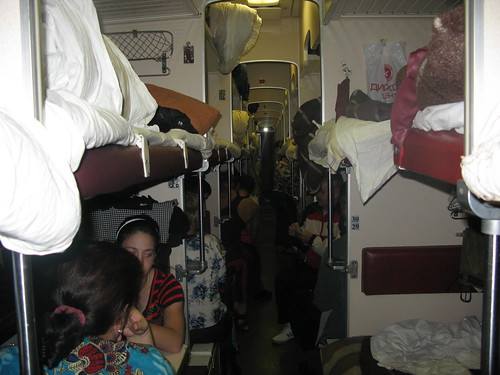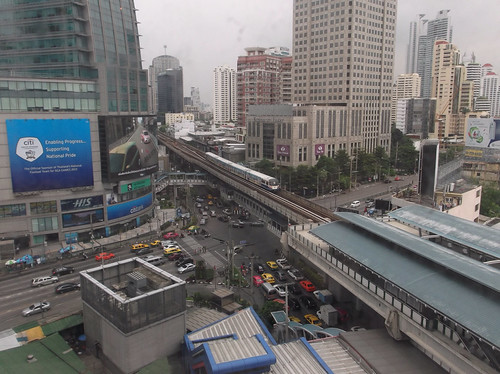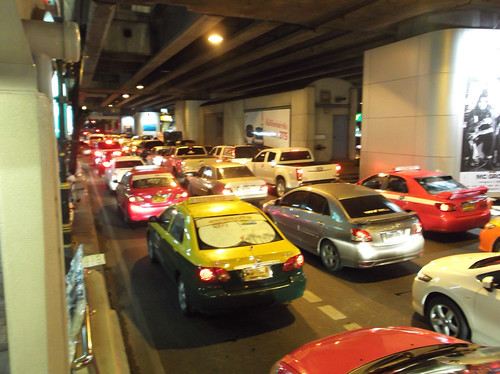In 68 days I traveled to Russia, Mongolia, China, Vietnam, Thailand, and Taiwan, a journey of 22,428 miles with 7,566 miles by train. My total cost was $5,300 or about $78 per day.
My hotel costs were $1,032 for an average of $18 per night. Taiwan was the most expensive averaging $23 per night. Most of the rooms had A/C, were very clean and neat, had in-room bathrooms with hot water showers, located near tourist spots and metro stations, and TV with mostly BBC or a fair and balanced showing of Fox along with Al Jeezera.
My total Travel costs (includes Visas and tours) were $1,873:
- The United airfare trip from SEA to Moscow and return from Bangkok via Taipei, Taiwan to SEA cost 62,500 miles and $121.16. If I would have paid for these same flights, they would have cost me $4,565. The travel time from SEA to Moscow via Frankfurt is 13 1/2 hours and 7,275 miles. The travel time from Bangkok via Taiwan to Seattle is 14 3/4 hours and 7,637 miles.
- The Vietnam and China Visas cost $458, and the Russia Visa cost $198.
- The Tran-Siberian platzcart ( 3rd class-open bunk carriage) train from Moscow to Irkutsk cost $19.59—-a trip of 3,217 miles and 87 1/2 hours.
- The Tran-Siberian Mongolia Kupe (second class bunk carriage) train from Irkutsk to Ulaanbaatar, Mongolia cost $211.25——a trip of 700 miles and 32 hours.
- The 3 day-2 night in gers tour to the Karakorum and the Erdene Zuu Monastery cost $229, a round trip of 570 miles.
- The Tran-Siberian Mongolia Kupe train from Ulaanbaatar to Beijing cost $191.13—-a trip of 970 miles and 31 hours.
- The Vietnam trains, both hard sleepers and soft seats from Hanoi to Nha Trang cost $66.13 and 35 hours.
- The AirAsia air flight from Ho Chi Minh City to Bangkok costs $69. This flight is 444 miles and 1 1/2 hours.
- The remainder of the costs were for the buses, SkyTrain, metros, ferry boats, taxis, and moto-taxis.
No more travelers check and no more big money belt with a large stash of USD now that ATMs are so popular in all of the countries I visited.
I begin my trip with about $300 USD in $20s and about 10 one dollar ($1) bills just in case I cannot locate an ATM machine.
The Lonely Planet guides give me information about whether the airport has ATM machines. If LP does not show any, I check the airport website which also shows where in the airport the ATMs are located. I ran into a few ATMs that did not accept my ATM card which is affiliated with the Plus ATM network, so I just find another a block or less away. The exchange rate is better than the airport currency exchange shops and you just need to shop around and frequent the bank ATM that charges the least service fee. Since the fee is the same whether you take a small amount of money or large, I usually get a larger amount like around $250 to $300 USD in the local currency. Many places have a limit of about $100 to $175 that you can withdraw at any one time though. WARNING: DO NOT LOSE YOUR ATM CARD OR LEAVE IT IN THE MACHINE.
Frequent Flyer Miles
Since 2000, I've made 17 international trips to Europe, Asia, and Latin America using frequent flyer miles; plus another 14 to Mexico using a combination of frequent flyer miles or companion tickets (Alaska Air). We use our credit cards for almost all purchases to rack up a lot of miles. I do what is called "churning" my credit cards. To learn more about "churning" and how to maximize the frequent flyer programs go to the Frugal Travel Guy website. There, you will learn about some extreme "churners", how to get to your destinations and see some current credit card offers. With this trip, I got the last best deal with my United frequent flyer miles by using just 62,500 miles to fly from SEA to DME and from BKK to SEA with a 6-day stopover in TPE. When I returned home, I learned that now United has changed its frequent flyer program that now requires at least 80,000 miles to fly roundtrip to SE Asia which is the same as Delta.
Dead Panasonic Video Camera and mini iPad—32GBs Comes to the Rescue
For this trip, my mini iPad was a real lifesaver because my Panasonic video camera stopped working early on my trip during our rough drive in Mongolia. I ended up using my iPad to video the remainder of my trip. It worked OK, but the screen was hard to see in the bright sunlight and sometimes the record button feature did not respond when I wanted it to. It took a couple of stabs of my finger. Near the end of the trip, I also ran out of storage so I had to delete some photos and videos to make room for additional video.
I downloaded four-country Lonely Planet Guides—China, Vietnam, Thailand, and Taiwan to save me from carrying over three pounds of guide books and that worked out OK, provided I had a good hard copy city map. It was a bit awkward to try to use the maps as I walked along because the screen was hard to see in the bright sunlight, but it was good not to carry the extra weight.
Other travelers and the locals enjoyed seeing the photos and videos I had on the mini iPad, especially when they were in the picture.
WiFi spots at hotels, guesthouses, restaurants, airports, and other locations are much more available throughout the tourist areas of Russia and SE Asia than that found in the Seattle area.
The battery life was generally not a problem. Even on the Trans-Siberian trains, I found it easy to recharge my iPad.
The good news on the Panasonic Video Camera was that I had purchased a 3-year service contract for $75 that expires on July 31, 2015. When I got back I called, and they are now in the process of repairing it. I usually do not get extended warranty contracts, but with my past experience of broken video cameras, I had decided to buy it since the original price was about $475.
Exploding iPad Charger
However, I did have a problem with the charger since I left one at the train station cafe in Danang but was able to buy another one from a street vendor in Nha Trang. That one literally blew off the power plug in the Bangkok hotel. I got another replacement from a street vendor in Bangkok. When I was at the Taipei Airport, the iPad was not charging while I was using it so I stopped at an electronics store and got another charger plug with two USB ports, and this one charged right up while I was using it.
Logitech Keyboard
My Logitech keyboard for the mini iPad began to have sticky keys and type errant characters after the characters I typed. I think it was the high temperatures combined with the high humidity that caused the problem. It cleared up when I kept the keyboard in an A/C room and when I returned to Seattle. Logitech is sending me a replacement keyboard.
Fuji Camera Dying
My Fuji compact camera that I bought as a replacement for the one that was stolen in Brazil was also beginning to fail by not focusing and by not responding when I clicked for a picture, and the face cover had fallen off. When I got to Bangkok, I bought a replacement camera——a Minolta S9200—-that was the kind Meng used in Mongolia. It cost just about $250 after my IVA refund. I liked it because you could clearly see the back screen even in bright sunlight, the lens was larger, the pictures seem clearer and crisper, and it took good videos. The video feature was useful now that my Panasonic video camera was dead.
Potable Water
Many travelers and locals buy and use plastic water bottles. I don’t like to see such a waste of resources with the bottles just going into landfill or recycled. In my past trips, I started my trips with a plastic liter bottle that I filled with local tap water and then used Aqua Mira chemicals to treat the water. For this trip, I changed to using a SteriPen Freedom along with with a wide mouth plastic bottle. The recharger cable for the SteriPen had a USB connection and also worked recharging my Logitech keyboard so I could use the iPad charger for this without bringing the SteriPen and Logitech charger which saved me about 4 oz. The purification process was quick—-about 1 1/2 minutes of UV light and no chemicals—compared to using Aqua Mira——-about 5 minutes for the two chemicals to mix and another 20 minutes for the water to be treated. I had no intestinal problems during the entire trip.
My Luggage
My total pack weight including my Golite Breeze Pack weighed in at 8.2 lb.. and by the end of the trip it weighed just 7.5 lb.. because I had used up my vitamins, tossed some of the old guide books and maps, the plastic liter bottle and bowl, the soap, deodorant, toothpaste, hair gel, and a pair of socks. I no longer carried a couple of novels.
My shirts, pair of pants, and underwear worked well with the frequent washings except that I wore out both pairs of socks so those were replaced. I also had to buy a replacement belt since mine broke. My rain jacket was useful for the frequent heavy rains so I did not bother this time to buy an umbrella.
Next time I will not carry a money belt since I don't carry much cash which will save another 3 oz.
Lost My altimeter/alarm/temperature/etc.Watch—-Travelguard Great!
When I got off the train in Ulaanbaatar, Mongolia, I had forgotten to put my watch back on. I had left it by my pillow since I had set the alarm for 4:30AM to be ready for our 5 AM arrival. The Khongar Hostel staff called the train station for me, without success. When I got home, I filed a claim for the loss with Travelguard. The Casio watch cost $175.20 and with the documentation, I provided to them—my homeowner's insurance showing that I had a $250 deductible, an explanation of the loss, the original receipt from REI, and proof of travel (my train and airline tickets), they reimbursed me $125.20 within a week from when I filed a claim with them. I have always had a good experience with them and the annual travel premium of $267 is one of the best values, especially with the emergency medical evacuation and care provisions.
How You Can Travel Cheaper than Me
There are two major opportunities for spending less than me on these kinds of trips: sleeping accommodations and food.
To spend less on sleeping accommodations, you could limit your stays to the cheapest dorms only, use the Couchsurfing website which provides "free" places to stay throughout the world, or camping—-stealth camping for free.
To spend less on foods, just limit yourself to street food, or shop in grocery stores. Most hostels have kitchens, refrigerators, and cooking facilities.
I enjoy eating well at the local restaurants as well as occasional street food venues and, as you can see from my costs, that my food costs were more than double my hotel costs and more than my travel costs---even with the length of this trip which covered more than 22,400 miles—-7,500 by train.
Where are the American Travelers?
This is another one of my trips where I have seen very few US Citizens individually traveling these since the 9/11 attacks. Most travelers I met in my Trans-Siberian—SE Asia travels were from other SE Asian countries, Europe, or Australia. On most of my train travel, I was the only American aboard. For the first day of my Trans-Siberian train ride, no one spoke English, and I relied on my Russian phrase section of the Lonely Planet guide to get around.
When I was booted off the night train to Hanoi, for four days I did not see any Westerners or speak English with anyone until I got to the minivan in Vietnam that would take me to Hanoi. Sharon and Wendy were Vietnamese who were returning from their Chinese language classes and also were fluent in English. They told the driver where to drop me off in the Old Quarter of Hanoi since their homes were before the van got to Hanoi.
When I did see Americans, they were usually traveling in groups of what I call the "American Tour Bubble". They would be seen in groups of 8 up to a full busload at the typical tourist locations being dragged around by their local guide who would be prattling endlessly about what they were seeing. Or I would see them all together in restaurants at large tables with the guides explaining what they were about to eat and/or performance to be observed while eating.
I did meet a few Americans who were on vacation from their English classroom. Either through a sense of adventure or lack of success in finding a job in the US, they had come to SE Asia to teach English. They had teaching contracts in Korea, China, Taiwan, Thailand, and Vietnam. Some of the contracts provided apartments, meals or food allowances, bicycles or motorbikes, annual return flights home, vacation times that matched the school year, plus a modest salary. Taiwan required that English teachers in public schools had to have a passport from an English speaking country, but the others and private schools did not have such requirements, nor did they require any specific teacher training. For recent college grads who are struggling with finding meaningful work, this would be a wonderful opportunity to see other parts of the world and bolster their resumes.
Subscribe to my YouTube Channel
I have recently uploaded all of my travel videos to YouTube now that they allow longer uploads. I have also added other shorter travel videos.
That link is https://www.youtube.com/c/huntforgold
If you do go there, please subscribe to my video channel since it will help me eventually get some income there and help with my future travels.



























































